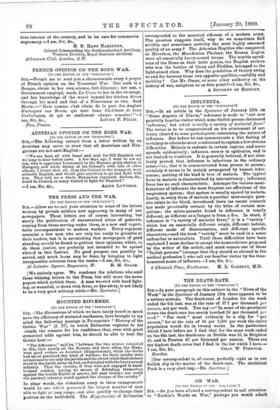MOUNTED RIFLEMEN.
[TO THE EDITOR OF THE "SPECTATOR."] SIR, —The discussions of which we have lately heard so much as to the efficiency of mounted marksmen, have brought to my mind the following passage in Procopius's "History of the Gothic War" (I. 27), in which Belisarins explains to his .riends the reasons for his confidence that, even with great numerical odds against him, he should be able to beat the
Gothic host :—
" The difference," said he, "between the two armies consisted in this, that nearly all the Romans and their allies, the Huns, were good archers on horseback (Hippotoxotai), while the Goths had never practised this kind of warfare; for their cavalry were accustomed to use only the javelin and the sword, while their archers stood in the battle array on foot, and mingled with the heavy armed infantry. Thus the cavalry, if they were not engaged in hand- to-hand combat, having no means of defending themselves against the hostile flights of arrows, fell easy victims, nor could the (archer) infantry stand against the charges of the cavalry."
In other words, the victorious army in these engagements would be one which possessed the largest number of men able to fight at long range, and also quickly to change their position on the battlefield. The llippotosotai of flalisarins
corresponded to the mounted riflemen of a modern army. The question suggests itself, why do we sometimes find solidity and sometimes mobility the most highly esteemed quality of an army P The Athenian Hoplites who conquered at Marathon, the Macedonian Phalanx, the Roman Legion were all essentially heavy-armed troops. The nimble squad- rons of the Huns on their little ponies, the English archers who won the battles of Crecy and Flodden, belonged to the light-armed class. Why does the pendulum of victory swing to and fro between these two opposite qualities,—solidity and mobility ? Can Mr. Oman, or some other authority on the history of war, enlighten us on this point P—I am, Sir, &a,
A STUDENT OF HISTORY.






































 Previous page
Previous page